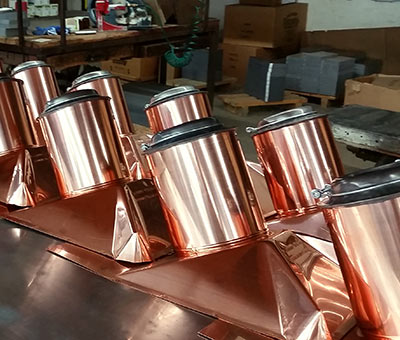Just How Copper Products Contribute to Lasting Practices in Different Industries
In sustainable energy systems, for example, copper improves the performance of solar and wind innovations, while its application in building lessens waste through longevity. As sectors look for to adopt more lasting techniques, the function of copper might show critical in attaining environmental goals.
Copper in Renewable Resource
Copper plays a critical function in the innovation of renewable resource modern technologies, acting as an important conductor in numerous applications. Its exceptional electric conductivity and resistance to deterioration make it an ideal material for electric wiring, which is necessary in photovoltaic panels, wind generators, and power storage space systems. In solar photovoltaic systems, copper is utilized in the affiliations and circuitry, making it possible for reliable energy conversion from sunlight to power.
In wind energy, copper is important to the generators and transformers that transform kinetic energy right into electric energy, ensuring optimum efficiency and dependability. Additionally, the need for electric lorries (EVs) is increasing, with copper being an essential part in batteries, electric motors, and billing infrastructure. The change to EVs significantly enhances the need for copper, as these cars generally use 4 times a lot more copper than standard interior burning engine vehicles.
As the globe looks for to alleviate environment adjustment and change to sustainable power resources, copper's role becomes progressively important. The material not only boosts the performance and resilience of renewable energy systems but also supports the broader goal of lowering greenhouse gas exhausts and promoting a sustainable future.
Eco-Friendly Building And Construction Materials
Recently, there has actually been a remarkable change in the direction of the adoption of environmentally friendly building and construction materials in reaction to growing ecological problems. This adjustment is encouraged by the need for lasting options that reduce eco-friendly footprints while maintaining structural integrity and aesthetic allure.
Copper, known for its resilience and recyclability, has actually become an essential player in this sector. It can be made use of in roof covering, pipes, and electrical systems, adding to power effectiveness and reducing waste. Copper's longevity indicates less replacements with time, additional boosting its sustainability profile.
Additionally, products such as bamboo, redeemed timber, and reused steel are acquiring appeal. These options not only offer minimized ecological impact but likewise advertise resource conservation. As developing codes increasingly emphasize sustainability, contractors and architects are integrating these materials right into their jobs, cultivating technology in layout.
The increasing adoption of eco-friendly construction materials mirrors a wider dedication to sustainability in the developed setting. By prioritizing these products, the building and construction sector can significantly decrease its carbon footprint, align with regulatory standards, and sustain a much healthier ecological community for future generations. This fad marks an essential action in the direction of an extra sustainable future in building.
Copper's Duty in Medical care
Current research studies have highlighted the substantial duty of copper in medical care setups, especially because of its antimicrobial properties. Copper surfaces have actually been revealed to minimize the existence of pathogens, including germs and viruses, by up to 99.9% within a brief period. This exceptional efficacy makes copper an indispensable material for high-touch surface areas in medical facilities, such as doorknobs, bed rails, and IV posts, thereby adding to improved infection control steps.
Along with its direct antimicrobial effects, copper likewise contributes in the wider context of healthcare facility sustainability (Copper Products). By integrating copper right into medical equipment and furnishings, health care centers can minimize the incidence of healthcare-associated infections (HAIs), which not only enhances person results but also lowers the expenses connected with extended health center remains and additional treatments
In addition, copper's resilience and recyclability straighten with sustainable practices, permitting responsible source administration. As my latest blog post healthcare systems increasingly focus on both person safety and ecological stewardship, the combination of copper products is ending up being extra common. This dual advantage highlights copper's learn the facts here now essential payment to a healthier, safer, and more lasting healthcare setting.
Sustainability in Transportation

Moreover, copper's longevity and corrosion resistance add to the durability of transportation framework (Copper Products). In rail systems, as an example, copper elements improve the dependability and performance of signaling and power systems, important for lowering hold-ups and power consumption. Furthermore, copper's function in renewable resource systems, such as solar and wind, sustains sustainable transportation options by giving tidy energy for electrical transportation options
Investments in copper technology not just foster sustainability but likewise promote financial development and task production in green industries. As markets aim to fulfill stringent ecological policies, the application of copper items in transportation becomes a crucial strategy in accomplishing sustainability objectives and advertising a cleaner, a lot more reliable future.
Copper and Circular Economic Situation
As the globe progressively embraces sustainability, the function of copper in the circular economy comes to be ever before more substantial. Copper's intrinsic residential properties-- such as its conductivity, durability, and recyclability-- placement it as a key product in a resource-efficient economy. The circular economic situation aims to decrease waste and optimize source use via recycling and reusing products, and copper master this respect.
The steel can be recycled indefinitely without loss of high quality, making it a perfect prospect for sustainable techniques throughout numerous markets, consisting of building, electronic devices, and renewable resource. By recuperating and reprocessing copper from end-of-life products, sectors can dramatically lower the requirement for virgin products, thus reducing environmental impacts connected with mining and handling.
Furthermore, the assimilation of copper right into circular economy frameworks not just preserves sources yet additionally fosters advancement. Services that prioritize copper recycling add to a more sustainable supply chain, boosting their competition while lining up with governing needs and customer choices for eco accountable items.
Conclusion
To conclude, copper products substantially add to lasting techniques across numerous fields. Their important duty in enhancing renewable resource innovations, advertising environment-friendly construction products, supporting infection control in medical care, assisting in lasting transportation, and personifying the concepts of a circular economic climate highlights the flexibility and value of copper. By click here for more integrating copper right into different applications, industries can attain higher performance, reduce environmental impact, and align with international sustainability goals, eventually promoting an extra sustainable future.

Copper's superb conductivity makes it a preferred product in electric car (EV) systems, boosting power efficiency and performance. Additionally, copper's role in eco-friendly energy systems, such as solar and wind, sustains lasting transportation options by supplying clean power for electric transportation choices.
Their crucial function in improving eco-friendly energy technologies, promoting eco-friendly construction materials, sustaining infection control in healthcare, assisting in lasting transportation, and embodying the principles of a round economic climate highlights the convenience and value of copper.